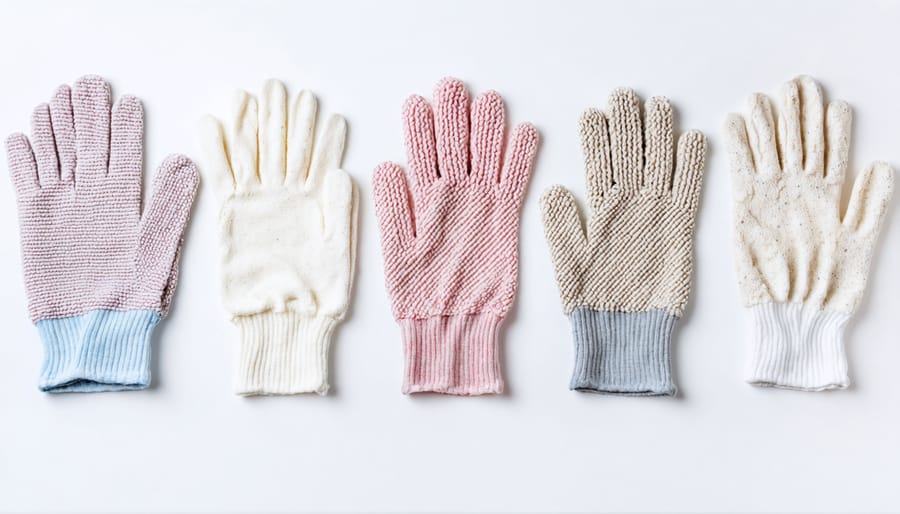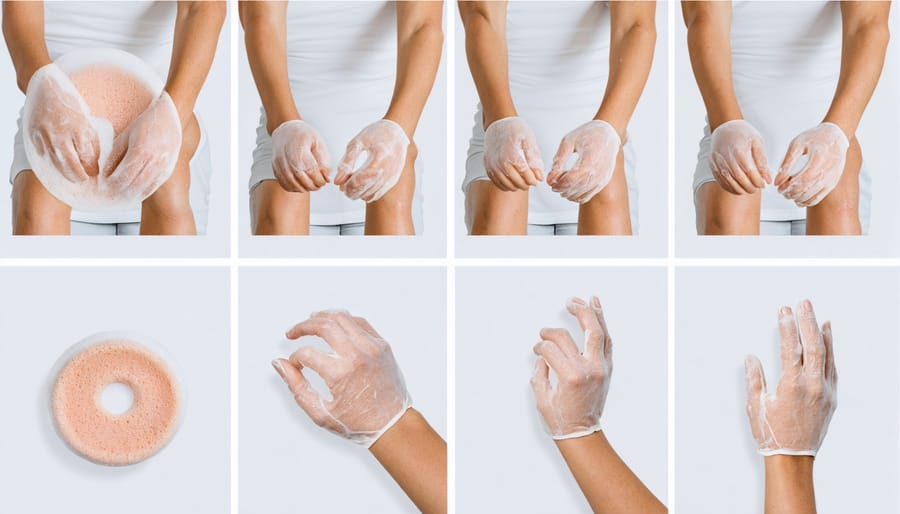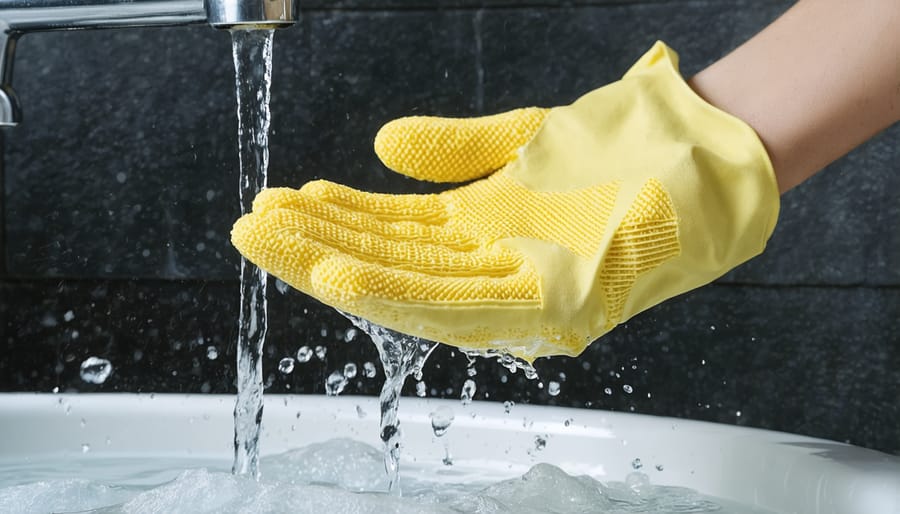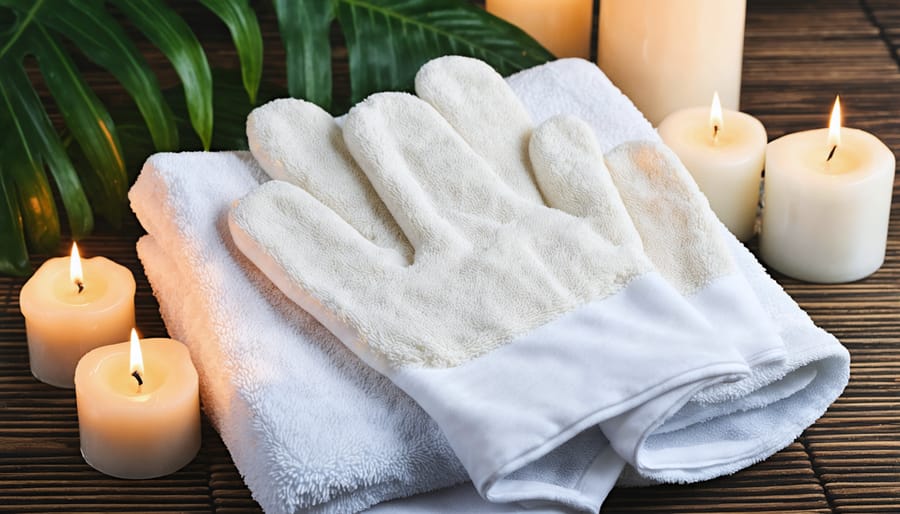Transform your skincare routine with exfoliating gloves, powerful tools that reveal smoother, healthier skin through gentle physical exfoliation. Understanding what exfoliating gloves are and how to use them properly can dramatically improve your skin’s texture and appearance. These specialized mitts effectively remove dead skin cells, boost circulation, and enhance the absorption of skincare products when used correctly. Whether you’re dealing with rough patches, preparing for self-tanner application, or simply aiming to maintain glowing skin, mastering the proper technique for exfoliating gloves can elevate your body care routine from basic to spa-level treatment. This guide will walk you through the essential steps to safely and effectively incorporate these valuable skincare tools into your regular routine, ensuring you achieve optimal results while avoiding common mistakes that could compromise your skin’s health.
Choosing the Right Exfoliating Gloves

Material Types and Their Benefits
Exfoliating gloves come in various materials, each offering unique benefits for your skin care routine. Nylon gloves are the most common and affordable option, providing effective exfoliation for all skin types. Their durable texture helps remove dead skin cells efficiently while being gentle enough for regular use. These gloves maintain their shape well and dry quickly, making them ideal for daily skincare routines.
Silk gloves offer a more luxurious and gentler approach to exfoliation, perfect for those with sensitive skin. Their soft texture provides mild exfoliation while helping to maintain skin moisture, making them an excellent choice for facial use and delicate areas. The smooth fibers are less likely to irritate the skin while still effectively removing dead skin cells.
Bamboo fiber gloves combine sustainability with effectiveness. These eco-friendly options are naturally antibacterial and hypoallergenic, making them suitable for all skin types, including sensitive and acne-prone skin. Bamboo fibers are also highly absorbent and offer natural temperature regulation, providing a comfortable exfoliating experience while being environmentally conscious. The material’s natural properties help prevent bacterial growth, ensuring a more hygienic skincare routine.
Matching Gloves to Your Skin Type
Selecting the right exfoliating gloves for your skin type is essential for safe and effective exfoliation. If you have sensitive skin, opt for gloves with a softer, more delicate texture to prevent irritation. Medium-textured gloves work well for normal skin types, providing balanced exfoliation without being too harsh. Those with oily or thicker skin can typically tolerate more textured gloves that offer deeper exfoliation.
Test the gloves on a small area of your skin first, such as your inner arm, to check for any adverse reactions. If you experience redness or irritation, switch to a gentler option. Remember that your skin’s sensitivity can change with seasons and stress levels, so you may need different textures throughout the year. When in doubt, start with a gentler option and gradually work your way up to more textured gloves as your skin adapts.
Proper Exfoliation Technique
Pre-Exfoliation Preparation
Before starting your effective exfoliation routine, take a few essential preparatory steps. First, soak in warm water for 5-10 minutes to soften your skin – a shower or bath both work well. Ensure your skin is clean by washing with mild soap to remove surface dirt and oils. If you have any cuts, scrapes, or skin irritations, wait until they heal before exfoliating. Remove any makeup and avoid applying lotions or oils beforehand. Test the water temperature to make sure it’s comfortable but not too hot, as excessive heat can make your skin more sensitive. These simple preparation steps will help maximize the benefits of exfoliation while protecting your skin.
Correct Motion and Pressure
When using exfoliating gloves, apply gentle circular motions, working from your feet upward toward your heart. This natural direction helps promote healthy circulation. Use light to moderate pressure – you should feel a slight friction but never discomfort or pain. Think of it as giving yourself a gentle massage rather than an intense scrub.
Start with your feet and legs, moving in small circles about the size of a quarter. As you reach softer areas like your stomach and chest, decrease the pressure slightly. For sensitive zones like inner arms or neck, use extra-gentle strokes. If you experience any redness or irritation, you’re applying too much pressure.
Remember to be especially careful around bony areas like ankles, knees, and elbows. These regions often need exfoliation but can be more sensitive to pressure. Take your time and listen to your body’s signals – if something feels uncomfortable, ease up immediately.
For optimal results, spend about 30 seconds on each body part, maintaining consistent, rhythmic movements throughout your exfoliation routine.

Post-Exfoliation Care
After exfoliating, it’s essential to care for your newly refreshed skin properly. Start by gently patting your skin dry with a clean, soft towel – avoid rubbing, as your skin may be more sensitive after exfoliation. Within three minutes of drying off, apply a gentle, fragrance-free moisturizer to lock in hydration and protect your skin barrier.
For the next 24 hours, be extra mindful of your skin’s needs. Skip harsh skincare products, including retinoids and acids, and avoid applying heavy makeup if possible. Your skin may be more sensitive to UV rays after exfoliation, so be sure to apply a broad-spectrum sunscreen with at least SPF 30 if you’re heading outdoors.
Keep your skin hydrated by drinking plenty of water and avoiding very hot showers or baths. If you notice any redness or irritation, apply a cooling aloe vera gel or gentle moisturizer. Wait at least 48 hours before your next exfoliation session to give your skin adequate time to recover and maintain its natural balance.
Remember that post-exfoliation care is just as important as the exfoliation itself for maintaining healthy, glowing skin.
Frequency and Safety Guidelines
How Often to Exfoliate
Understanding how often to exfoliate is crucial for maintaining healthy skin. The frequency largely depends on your skin type and sensitivity level. For those with normal to combination skin, using exfoliating gloves 2-3 times per week is generally safe and effective. If you have sensitive skin, limit exfoliation to once per week and observe how your skin responds.
Individuals with oily or acne-prone skin may benefit from exfoliating up to 3-4 times weekly, as this helps prevent clogged pores and buildup. However, those with dry or mature skin should stick to 1-2 times per week to avoid irritation. During winter months or in dry climates, consider reducing frequency to protect your skin’s moisture barrier.
Pay attention to your skin’s signals – if you notice redness, irritation, or increased sensitivity, reduce the frequency immediately. It’s better to start with less frequent exfoliation and gradually increase as your skin adapts. Remember that over-exfoliation can damage your skin’s protective barrier, so more isn’t always better.
When to Avoid Exfoliation
While exfoliating gloves can be beneficial for many people, there are times when you should avoid using them. If you have active skin conditions like eczema, psoriasis, or severe acne, wait until your skin has healed before exfoliating. Sunburned, windburned, or irritated skin should also be given time to recover.
Avoid exfoliation if you have open cuts, wounds, or recent surgical scars. People who use certain medications, particularly retinoids or acne treatments, should consult their healthcare provider before incorporating exfoliating gloves into their routine, as these products can make skin more sensitive.
It’s also important to skip exfoliation during active infections, cold sores, or rashes. If you’ve recently had cosmetic procedures like chemical peels or microdermabrasion, wait until your skin has fully healed before resuming exfoliation.
Listen to your skin – if you notice increased redness, irritation, or sensitivity, take a break from exfoliating. During Canadian winters, when skin tends to be drier, you may need to reduce the frequency of exfoliation to maintain healthy skin barrier function.
Maintenance and Hygiene
Cleaning Your Gloves
To maintain hygiene and extend the life of your exfoliating gloves, proper cleaning is essential. After each use, rinse your gloves thoroughly with warm water to remove dead skin cells and product residue. Apply a small amount of mild, antibacterial soap to the gloves and gently work it into the fabric, paying special attention to the textured areas. Rinse again until the water runs clear and all soap is removed.
Hang your gloves to air dry completely in a well-ventilated area, away from direct sunlight. Avoid leaving them in the shower or humid bathroom environment, as this can promote bacterial growth. For deeper cleaning, soak the gloves in hot water with a splash of white vinegar for 15 minutes once a week.
Replace your exfoliating gloves every 3-4 months, or sooner if you notice signs of wear, deterioration, or persistent odours. Regular cleaning and proper care will ensure safe and effective exfoliation while preventing the spread of bacteria.

When to Replace Your Gloves
Regular maintenance and timely replacement of your exfoliating gloves are essential for both effectiveness and hygiene. As a general rule, replace your gloves every 3-4 weeks if you use them 2-3 times per week. If you notice any of these signs, it’s time for a new pair: fraying or loose threads, a change in texture (becoming too soft or rough), lingering odours even after washing, or visible discolouration that doesn’t wash out.
Pay attention to how the gloves feel during use – if they’ve lost their exfoliating properties or feel uncomfortably harsh, replace them immediately. Storing gloves in a damp bathroom can accelerate wear and promote bacterial growth, so consider this when determining replacement timing. Even if your gloves appear clean, microscopic buildup of dead skin cells, bacteria, and body oils makes regular replacement necessary for optimal skin health and hygiene.
For best results, mark your calendar when you start using a new pair and set a reminder for replacement. This simple habit will help maintain the effectiveness of your exfoliation routine while protecting your skin health.
Regular exfoliation with gloves can be a wonderful addition to your skincare routine when done correctly and mindfully. Remember to always use gentle pressure, maintain proper hygiene of your exfoliating gloves, and listen to your skin’s needs. Start with twice-weekly sessions and adjust based on how your skin responds.
Keep in mind that while exfoliation offers excellent benefits like improved circulation and smoother skin, overdoing it can lead to irritation. Clean your gloves after each use, allow them to dry completely, and replace them every 3-4 weeks to maintain good hygiene and effectiveness.
For best results, incorporate exfoliating gloves as part of a comprehensive skincare routine that includes proper cleansing, moisturizing, and sun protection. If you experience any unusual redness, irritation, or discomfort, reduce frequency or consult with a healthcare provider.
With consistent and proper use, exfoliating gloves can help you achieve healthier, more radiant skin while promoting overall skin wellness. Remember that everyone’s skin is different, so pay attention to what works best for you and adjust your routine accordingly.

